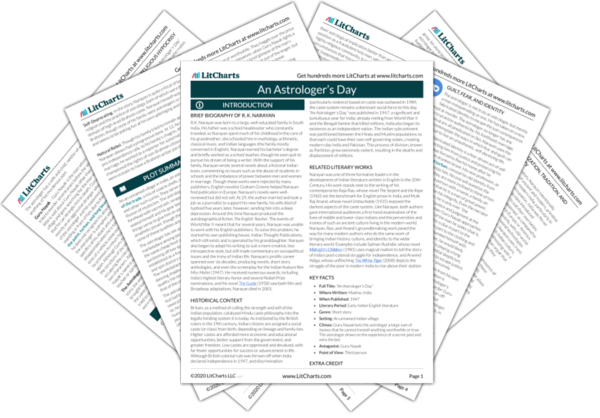Welcome to the LitCharts study guide on R. K. Narayan's An Astrologer’s Day. Created by the original team behind SparkNotes, LitCharts are the world's best literature guides.
An Astrologer’s Day: Introduction
An Astrologer’s Day: Plot Summary
An Astrologer’s Day: Detailed Summary & Analysis
An Astrologer’s Day: Themes
An Astrologer’s Day: Quotes
An Astrologer’s Day: Characters
An Astrologer’s Day: Terms
An Astrologer’s Day: Symbols
An Astrologer’s Day: Theme Wheel
Brief Biography of R. K. Narayan

Historical Context of An Astrologer’s Day
Other Books Related to An Astrologer’s Day
- Full Title: “An Astrologer’s Day”
- Where Written: Madras, India
- When Published: 1947
- Literary Period: Early Indian English literature
- Genre: Short story
- Setting: An unnamed Indian village
- Climax: Guru Nayak bets the astrologer a large sum of money that he cannot foretell anything worthwhile or true. The astrologer draws on the experience of a secret past and wins the bet.
- Antagonist: Guru Nayak
- Point of View: Third person
Extra Credit for An Astrologer’s Day
Self-Deprecating. In the story, Narayan is quite critical of both religion and the practice of astrology, both of which were the domain of high-level Brahmin caste. Narayan himself was a Brahmin, though none of his family were astrologers or priests, and seems to be poking fun at his own upbringing and peers.
Natural Rebel. Though his family tried to remain apolitical, Narayan always had a progressive bent. At 12, he marched in a pro-independence rally, to his family’s chagrin. After his marriage, he worked as a reporter for a journal that championed the rights of non-Brahmin citizens; his employers were ecstatic to have a Brahmin writer join their ranks.







